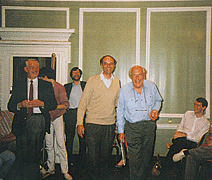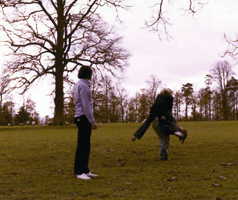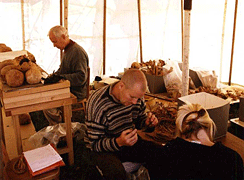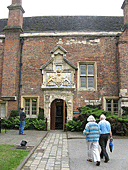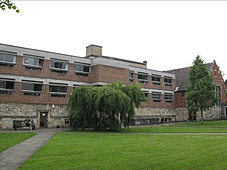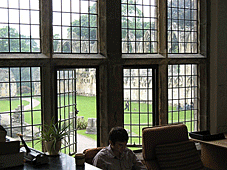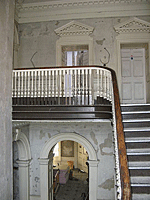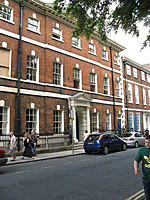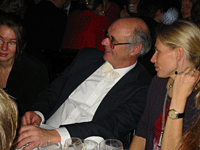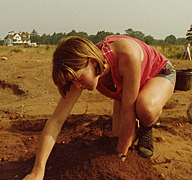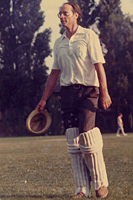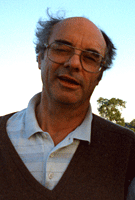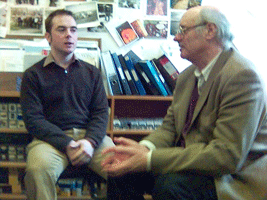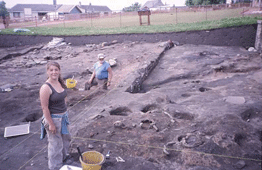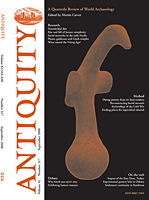York & Antiquity
Contents:
Teaching at York
Here colleagues and former students show in their various ways their appreciation of Martin in his post at the Department of Archaeology at the University of York.
Philip Rahtz, Emeritus Professor at York and the first occupant of the Chair of Archaeology at the University of York, created in 1978, writes:
"It seems strange to me that Martin is retiring - it doesn't seem that long since he was appointed, so fast has time gone. I've been continually delighted that, under his guidance, the department which I had the privilege of starting has become so prestigious.
I have known Martin for many decades. We first came into contact when I was at Birmingham and he was a free-lance archaeologist, as I had been - his development and importance to archaeology was never in doubt. We have in common that neither of us started with a full academic education [in archaeology] and we have both shared a love of archaeology in all its guises. We are close in our interests and outlook on life and it's been very interesting to see how Sutton Hoo and Tarbat have been so extraordinarily successful. Antiquity, under his hands, has developed both a renewed importance and also brought much to York. I've enjoyed an enlivened read under his editorship.
I don't know how unusual it is fro an ex-professor still to be around when his successor retires, but I'm very pleased to have lived long enough to see how then Department of Archaeology has flourished in his hands, as has his own career and wider life. I hope he has as long a retirement as I have had and is able to continue to be active and influential. I also hope our friendship will last for many years to come. Happy retirement!"
PHILIP RAHTZ
Tania Dickinson, the first lecturer to be appointed in the Department of Archaeology at York and eminent Anglo-Saxonist, writes:
"Here is my earliest memory of Martin or rather, in the face of my feeble brain, the photograph has become the memory. The place was Brockhampton Park, Herefordshire, the date 1977, and the occasion my visiting Lower Linceter, Sue Hirst's 'country house' idyllically set amongst the Worcestershire orchards. Martin and Madeleine, respectively Director of WEMRAC and a student in the Department of Ancient History and Archaeology at Birmingham, lived there in a breeze-block barn. A lithe Martin letting his hair down in a game of leap-frog encapsulates his joie de vivre, but might not seem relevant to archaeology or York. On the same occasion, however, Philip Rahtz and Lorna Watts were also guests at Linceter: there was much talk of the establishment of a new Department of Archaeology at York, and of Philip's chances of being selected as the first professor - very slim, he thought. Little did we imagine that Philip would be selected, that a year later I would be appointed as the first lecturer in the Department, and that Martin would succeed to the Chair on Philip's retirement. Isn't history fascinating, Martin, our own and that of the early Middle Ages! I wish you the very best for your 'retirement'."
TANIA DICKINSON
Don Brothwell, Emeritus Professor at York and very active member of the Bioarchaeology group, writes:
"About seventeen years ago, I wrote to Martin from the Institute of Archaeology in London, to say I intended to spend my final academic years beyond London in another university. My feeling was that York would be ideal. I had been involved with York students between 1968 and 1973, when some of Sid Bradley's students came to excavate with me in the Orkneys. I had also been involved in the development of the York Environmental Archaeology Unit, and I had always considered that there was great potential for the expansion of archaeological science in York University - particularly Bioarchaeology. With the creation and development of an archaeology department, this seemed a distinct opportunity, and most importantly when I discussed this with Martin, I got a very enthusiastic response. I don't know to what extent Martin had a hard time arranging for me to be taken on by the University, but fortunately Ron Cook, the new vice-chancellor and environmental geographer, must have looked favourably on the proposal by Martin. So I have Martin's enthusiasm and support to thank for my arrival in York, and I'd like to say that having previously been involved in teaching at Cambridge and London, my time in York has been the most pleasant of all. Martin's initial effort to get me to York has been followed by the further expansion of Bioarchaeology, in collaboration with the Biology and Chemistry departments. So Martin, I believe your initial and long-term support has resulted in the creation of the best team of university researchers and teachers in Bioarchaeology in Britain, if not in Europe and beyond. I hope that university history will give you proper credit for this."
DON BROTHWELL
Matthew Collins, Professor of Bioarchaeology at the University of York, heads BioArch, a joint initiative between the departments of Biology, Chemistry and Archaeology (he is also Professor at the Vrije Universiteit Amsterdam). He writes:
"Ever since meeting Martin for the first time (at the BBC launch of Blood of Vikings held at the Jorvik Centre) he has been an inspiration. Little did I realise, having admitted to him, that much of the new field of 'biomolecular' Archaeology was over-sold, that soon I would be joining his department as a well ..., er..., um..., Biomolecular Archaeologist! My job was mortgaged against this retirement, so I have more reason than most to be grateful to him.
As a newbie in the Department and in Archaeology, Martin was a tremendous support, not only intellectually but also practically, giving freely of his time to an ignorant upstart. Martin's strongly held views, on field archaeology, the role of science, and future directions in the field are shared with conviction, wit and good humour.
Martin's great strength is his enduring enthusiasm for the whole of subject. Everything about archaeology seems to interest and excite him. His knowledge is encyclopaedic and his passion heartfelt. I cannot imagine anyone better suited to editing the flagship journal Antiquity. Remarkably Martin undervalues himself; we now learn that the daily rate he charges is lower than your average plumber, what a bargain!
I am delighted that he has been made an Emeritus Professor; the Department without Martin would be like York without the Vikings, perhaps a little tidier, but much less interesting."
MATTHEW COLLINS
Julian Richards, the current Head of Department and fellow early medievalist and editor, writes:
"Martin has been a part of my archaeological career for the last 40 years. From my first encounter with him as an earnest research student who wanted to discuss single context planning in Stafford, to working together in our shared commitment to the Department of Archaeology in York, I have been impressed by his tolerance of the young. On IFA Council I witnessed his skilled navigation of the competing ethical priorities created by the WAC schism; at Sutton Hoo I watched how a general runs an excavation. The dinner parties at East Mount Road were a hallmark of an academic world that once existed but is now too often lost under the weight of management accountants and health and safety audits, and will be remembered by all. Throughout his time in York, Martin has been both an inspiration and a stimulus. I know that this won't stop with his retirement and that there are generations of York students to come who will learn from him, and hopefully also a few bureaucrats who will be exasperated by him. Long may this continue."
JULIAN RICHARDS
Jane Grenville, who was Head of the Department of Archaeology between 2001 and 2006, is now Pro-Vice-Chancellor for Students at the University of York. She recalls her first encounter with Martin in an 'eerily deserted Micklegate House' [though it was not as bad as this 2008 picture of its interior; Priscilla's office was on the left, Martin's on the right].
"I turned up for my first day at work in 1988 and found myself in an eerily deserted Micklegate House. I'd been interviewed about six weeks previously and was to work principally with Richard Morris at the CBA but as a Research Associate of the Department, and for that reason, I'd been instructed to report to Prof Carver in the departmental office that soggy October morning. There was no Priscilla [Roxburgh, the Departmental administrator from 1978 to 2005] that day. After a while, Martin appeared in a really awful mac (which happily I don't think I ever saw again) so I smiled hopefully as he swept past, a galleon in full sail, and into his room. I waited. Some time later he re-emerged and I tried my very best new girl smile. 'Priscilla's gone to Harrogate for the day", he said, which didn't help much since at that stage I had no idea who Priscilla might be. 'Oh really?" I said, weakly. 'Well, you are looking for her, aren't you?" 'No, you, actually - I'm the new CBA Historic Buildings Officer, I was told to come here on my first morning." 'Good God! But you look completely different! What have you done? Have you dyed your hair?" And so began a rich, sometimes combative, always inspiring friendship. Thanks, Martin - I'm not taking your 'retirement' too seriously - here's to more!"
JANE GRENVILLE
Steve Roskams, who has been a lecturer in the Department since the very early days, shares Martin's conviction that field archaeology deserves debate. He writes:
"I first crossed paths with Martin longer ago than either of us probably want to remember (some three decades), introduced by a mutual friend at a party. We first crossed swords, however, albeit in friendly fashion, at a conference in Birmingham organised (inevitably) to discuss the role of recording in archaeology. I don't really remember what we actually argued about but do remember that commonality of interest. Here was someone who had the same interests as me and was prepared to think, and talk, about them, though not as if it was the most important thing in the world - serious, but not that serious.
A few years on, and we met again when I was on the interview panel to choose the replacement for Phillip Rahtz as Head of Department. I had expected the process of choosing the new Head to be a difficult one but, in the event, Martin made it easy for us. He was able to relate to the 'dirt digger' in me as easily as to the academic substance of Barry Cunliffe, the external advisor on the panel. Even the very snappy pin-striped suit which Martin wore that day did not put me off. So I will bask in reflected glory for having been part of the process that brought him to York.
Since his arrival here, having Martin around has been to my huge benefit, and to that of many others. Experiencing his ability to see things in an entirely different way from most people has been a rewarding exercise - something I had expected to get from the academic life but have encountered too rarely. Often I can't see what he is getting at, at least in the first instance (am I alone in this?), and sometimes I understand but don't agree (ditto). But on other occasions, he can be truly incisive, for example taking a research question for a student in a completely novel direction - truly remarkable. Finally, he has rescued me from the doldrums on important occasions. A few years ago, when I was finding it difficult to write anything for publication, he offered to co-author a paper, then surreptitiously dropped out when I had got going (though one reviewer still panned my piece and praised another of his in the same volume to the skies - perhaps he's more astute than I realised!).
Anyway, thanks for all the conversations and stimulation over the years, Martin. And for all those on this website who insist on putting the word retirement in quotes - ignore them. Go and relax - though I still expect to see you on site on a wind-swept hillside or down a deep hole encouraging me to use 'feature' recording sheets as part of the excavation process. You never know, one day I just might - but don't hold your breath."
STEVE ROSKAMS
Martin inspired many students, in the lecture theatre, in the seminar room, in the field and in supervisorials. Here some of his students tell us what it was like.
Neil Price, now Professor of archaeology at the University of Aberdeen, writes:
Memories of Martin
"I first met Martin in 1984 on a visit (also my first) to Sutton Hoo, just before the start of the project and the year before I went to university. He was alone on site, and gave me and Phil Emery - who later did an MA at York - an impromptu tour of the mounds with what I would come to realise was his usual charisma. Since then we've talked, drank and laughed at countless conferences and meetings, and I don't believe I've encountered anyone else who combines the same qualities of intellectual brilliance, vivid originality and, above all, wit: he's one of the most entertaining people I've ever met.
I got to know him better at York where I originally began my PhD, before 'failing to complete' and eventually finishing it 14 years later in Uppsala. In the end, Martin was my external examiner and he never let me forget how long it had taken to finally get the book written. Before the party after my defence, I shared with the examining committee a remarkable bottle of Madeira that I had been saving for the occasion, a vintage from 1870. Martin mentioned this in his after-dinner speech before adding, "and just think, the person who made it was still alive when Neil began work on his thesis". We all have so many memories of Martin, but for me what encapsulates him was the fantastic performance he gave earlier that day at the viva, which in Sweden is a public event. My doctorate was about Norse supernatural beings, and a sample of his speech, which was later published, gives the flavour: "We meet some delightful human characters in the other world, as cosy and quirky as any other community. Indeed they reminded me irresistibly of a typical University archaeology department: there were the bossy, the angry, the predatory, the sex-mad, the 'wind man' and of course 'the old one in furs'".
My doctoral research examined, amongst other things, a particular kind of iron staff used in the Viking Age practice of sorcery; my friends had presented me with a 'replica' that included, as I remember, large amounts of glitter, tinsel and a revolving disco ball on the top. My last sight of it [at the party that followed the examination, where this characteristic picture of Martin was taken] was when it was in Martin's hands as he led fellow revellers towards the dance floor at about two in the morning; I never did find out what he did with it!"
NEIL PRICE
Sam Turner, now lecturer in archaeology at the University of Newcastle, writes:
"Martin was my York PhD supervisor. I'd started under another advisor but we didn't see eye to eye, so (unbeknown to me) Tania Dickinson asked Martin if he'd take me on. When I returned to the King's Manor after the Christmas break - rather downhearted with lack of progress - Martin bounded across the courtyard and told me with a grin he was going to be my new supervisor. Knowing him only by his fearsome professional reputation I was struck with terror, but within a week or two I discovered how his challenging and rigorous manner was never confrontational, but tempered by generosity, warmth and a real concern to get the best out of his students.
Supervisions with Martin suited me perfectly. Mercifully they weren't too frequent (I think these were the days before universities laid down rules about the minimum numbers of supervision per month!), but whenever they did happen they were entertaining, illuminating and could lead to months of happy work. Martin allowed me to talk and present my plans - patiently asking for explanations of the most half-baked points - before firing out myriad ideas in the witty, learned and engaging style for which he is justly famous. Some of these we abandoned, and some I stole for my PhD, but all deserved careful consideration. The result of Martin's encouraging style was a relaxed, collaborative atmosphere that stimulated imagination and creativity, and really made supervisions an enjoyable, constructive experience.
I won't apologise if that sounds unduly adulatory - that's just how I remember it!"
SAM TURNER
Helen Geake, now Finds Adviser (Post-Roman Artefacts) to the Portable Antiquities Scheme at Cambridge University, writes:
"Martin supervised my DPhil at York from 1990 to 1995. When you do five years of research into a single topic, your focus inevitably narrows drastically and the wonderful thing about Martin was the way in which he always hauled me back again to look at the wider picture.
Half an hour with Martin (and a gin and whatever-there-is-in-the-fridge in your hand) and you go from feeling utterly pointless to seeing that your research is actually of national - no, European! - significance. We, here, now, are doing the most exciting work there is. This is the best place to be and right now we are going - we fourteen people around this table after a seminar - to have a good meal and a lot to drink and several cigarettes, and really make some progress in understanding why life is as it is.
Life with Martin is not just 'work' - not just understanding the past - but using the past and present to understand both. The party, the campfire, the two or three gathered together in a Portakabin with a bottle of whisky, provide insights which can then be tested in the field or the library. Living life helps to understand life.
Imagine my surprise when, towards the end of my DPhil, I found out that he had been doing other things all the time as well, like being Head of Department. Martin made me feel that nothing and no-one was more important and interesting than I was - and I've never felt quite the same way since."
HELEN GEAKE
The picture shows Martin after a few drinks at a staff/student cricket match, c. 1995.
Dan Hull, now Head of Information and Communications at the Council for British Archaeology, writes:
Nicky Toop, who is an essential member of the Tarbat team and of Field Archaeology Specialists (FAS), completed her PhD two years ago. She writes:"I have known Martin since my days as a timid undergraduate at Micklegate House in 1994. His World Archaeology course inspired and encouraged my interest in Islamic archaeology and the Middle East, and a few years later he became my PhD supervisor as I returned with wide-eyed ambitions of digging up a Syrian monastery. Martin diplomatically both redirected me and expanded my horizons, encouraging me to think landscape-wide and to begin asking bigger questions than I'd dared to do myself. Suddenly I found myself in supervisorials discussing everything and everyone from tax reform and phenomenology to Cassiodorus and Edward Said, and with a terrifying data 'set' ranging from Iraq to northern Scotland. Eventually, we pared this down somewhat, and I settled in for a thoroughly enjoyable research journey with Martin at the helm. He is tirelessly curious of spirituality, making me deconstruct but not dismiss its motivations, and leading me to examine the interface between religious fervour and social rebellion. On a not unconnected theme, we also worked together on the Diversity in the Curriculum Project (with Wendy Romer) in 2005, devising and discussing ways of broadening social diversity within our undergraduate intake. After 10 years this brought me back to his World Archaeology course - still showing us all the breadth of questions that can be asked, and the endless diversity, of the human journey."
DAN HULL
Back to top"Martin's enthusiasm was probably partly responsible for me applying for a PhD in the first place, and had you asked me during my final year of writing up I wouldn't always have been suitably grateful for that encouragement! Having said that, the end product was worth it, and I would never have completed the thesis without the comments, challenges and ideas that he provided over the four years. While juggling hundreds of projects at once, Martin always managed to find time for reading and commenting on work, and supervision sessions in his hectic office were always entertaining as well as useful. As my supervisor, I benefited from his hallmark critique tempered with kindness - he could take a hurriedly-written chapter, tear it apart, and take it off in many new directions (and sometimes back again), yet afterwards you'd still feel confident about writing the new version. As someone who appears to have an unending supply of ideas, he is very generous with them - more than once offering praise for an idea that he provided in the first place!"
NICKY TOOP
EDITING ANTIQUITY
"Our field is the Earth, our range in time a million years or so, our subject the human race." (O.G.S. Crawford, founder of Antiquity in his first editorial in 1927).
Becoming editor of Antiquity was, and continues to be, a huge privilege. Martin writes in his first editorial (March 2003, Antiquity 77: 5):
"The editorial policy (...) remains the same as it has for 75 years - to present the results of recent research to the extended archaeological family. (...) In these days of increasing specialisation, even researchers in different periods sometimes have difficulty understanding each other, while a thickening fog continues to rise between archaeologists in Universities and those serving the commercial sector. Our extended archaeological family includes not only all these professionals, and those of other disciplines with whom we work - chemists, linguists, geneticists - but people in other walks of life for whom the revelations of the past can provide a sustaining nectar. Thirty years ago your new editor was such a person..."
In the past 5 years, while excellence as a learned journal evidently remains the top priority, that aim of making even the most abstruse academic article comprehensible to the extended archaeological family has never been lost. In 2008 Antiquity will have received around 240 article submissions, published 78 in the journal (research, debate and method articles, as well as a substantial reviews section) and almost as many online in the Project Gallery. The York team consists of Martin (editor), Jo Tozer (editorial manager) and Madeleine Hummler (reviews editor), backed by Portland Press who produce the journal and with the direction and support of the Antiquity Trust (Professors Warwick Bray, John Coles, Barry Cunliffe, Anthony Harding, Paul Mellars, Colin Renfrew, Stephen Shennan and Graeme Barker) and the Antiquity Company directors (Dr Joan Oates, Prof Martin Millett, Prof Anthony Snodgrass, Chris Evans, Andrew Rogerson, Richard Skaer and Roger Guthrie)
Joan Oates, chairman of the Antiquity Company between 2002 and 2006 writes:
"Martin Carver is a man of many parts. One of his most recent roles has been as Editor of Antiquity, one of the oldest and most prestigious archaeological journals. Antiquity was founded by O.G.S. Crawford in 1927 as an independent journal, which it remains to this day. Now owned by the Antiquity Trust, set up under the editorship of Glyn Daniel (1958), all editors following Crawford (Martin is the fifth) have remained faithful to Crawford's desire to present worldwide archaeological discoveries quickly to the widest possible readership, a hallmark of Antiquity.
An extremely 'hands on' editor, Martin has covered, both in his editorials and his selection of papers, not only wide areas of archaeological science and discovery but also an extensive range of theoretical debates and matters of more general professional and public interest. Certainly the journal has remained both informative and eminently readable under his direction. As Editor he is responsible to the Trustees and, in the daily running of the journal, to the Directors of Antiquity Publications Ltd (owned by the Trust). Recently, with the assistance of Martin and the publishers, the Directors took two of the most significant decisions in the journal's history, to produce Antiquity simultaneously both online and in the paper version and to create an electronic archive of all the back numbers. These innovations have proved extraordinarily successful, and Martin is to be congratulated for the role he has played in these major changes.
Each Editor has stamped his or her own personality on the journal and in particular on the editorials. Certainly we look forward to Martin's wit and wisdom for the remainder of his editorship."
JOAN OATES
Antiquity volumes published under Martin Carver's editorship (to date)
- 2003, volume 77: 900 pages
- 2004, volume 78: 996 pages
- 2005, volume 79: 1013 pages
- 2006, volume 80: 1056 pages
- 2007, volume 81: 1152 pages
- 2008, volume 82: 1182 pages
In 2005 Antiquity was delighted to be Runner up in the Charlesworth Award for best journal from the Association of Learned, Professional and Scientific Publishers (ALPSP). Emily Smyth (now Morrell) went to get the prize. She was editorial assistant at Antiquity between 2003 and 2006, and is now publications manager at the Institute of Historical Research based in the University of London. She writes:
"Working for Martin at Antiquity was an interesting experience. It was my first 'proper' job and I had so much to learn, and working for Martin I was thrown in at the deep end. I realised what great skill Martin has at turning the most incomprehensible paper by a Japanese or Russian author into a fascinating, incisive piece of writing, and I learnt a lot. Thanks, Martin, for inspiring me with great ideas, listening to my opinions, giving me great work experience and making me smile. Have a fantastic retirement - try not to end up working even harder than you did before retirement - now's your chance to do the things you really want to do. Enjoy."
EMILY MORRELL
Part of the job of editor is to represent Antiquity at major international conferences, routinely attending such events as EAA, WAC, SAA and TAG, on the look-out for new research and feeling the pulse of archaeology. Martin has been a well-recognised figure on the conference circuit, never failing to enjoy the après-conference scene, but also relishing the exchanges during the serious parts as Neil Price recalls:
"I think my most vivid conference memory of Martin was from the '92 Medieval Europe at York, when he was chairing a session and closed it with a wonderful summing-up that perhaps went on a little too long. Someone in the audience clearly thought so, as a paper plane flew onto the stage from the auditorium, landing neatly at Martin's feet. He opened it up and laughed, turning it to the audience so they could read the block capital message inside: "SHUT UP".
NEIL PRICE
Thinking about publication (MOHC bibliography)
Already before becoming editor of Antiquity, how to publish archaeology was a major interest, and the editorship of Antiquity has allowed Martin to explore the subject further, including the future of learned journals.
- 1985. The friendly user, in M.A. Cooper & J.D. Richards (ed.) Current issues in archaeological computing (BAR S271): 47-61. Oxford: British Archaeological Reports.
- 1992 (with H. Chapman, B. Cunliffe, T. Hassall, M. Hebditch, A. Lawson, I. Longworth, R. Morris, D. Phillipson, J. Schofield & G. Wainwright). Archaeological publication, archives and collections: towards a national policy. London: Society of Antiquaries of London.
- 2007. The future of Antiquity, in M. Rundkvist (ed.) Scholarly journals between the past and the future: the Fornvännen centenary round-table seminar, Stockholmm 21 April 2006 (Konferenser 65): 30-49. Stockholm: Kungl. Vitterhets Historie och Antikvitets Akademien.
- In press 2008. Archaeology journals, academics and Open Access. European Journal of Archaeology.
